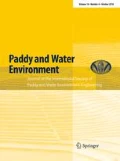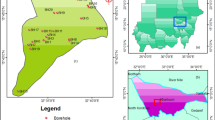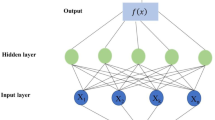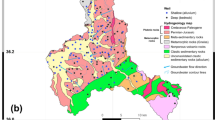Abstract
There is a growing concern about health hazards linked to nitrate (NO3) toxicity in groundwater due to overuse of nitrogen fertilizers in rice production systems of northern Iran. Simple-cost-effective methods for quick and reliable prediction of NO3 contamination in groundwater of such agricultural systems can ensure sustainable rural development. Using 10-year time series data, the capability of adaptive neuro-fuzzy inference system (ANFIS) and support vector machine (SVM) models as well as six geostatistical models was assessed for predicting NO3 concentration in groundwater and its noncarcinogenic health risk. The dataset comprised 9360 water samples representing 26 different wells monitored for 10 years. The best predictions were found by SVM models which decreased prediction errors by 42–73 % compared with other models. However, using well locations and sampling date as input parameters led to the best performance of SVM model for predicting NO3 with RMSE = 4.75–8.19 mg l−1 and MBE = 3.3–5.2 mg l−1. ANFIS models ranked next with RMSE = 8.19–25.1 mg l−1 and MBE = 5.2–13.2 mg l−1 while geostatistical models led to the worst results. The created raster maps with SVM models showed that NO3 concentration in 38–97 % of the study area usually exceeded the human-affected limit of 13 mg l−1 during different seasons. Generally, risk probability went beyond 90 % except for winter when groundwater quality was safe from nitrate viewpoint. Noncarcinogenic risk exceeded the unity in about 1.13 and 6.82 % of the study area in spring and summer, respectively, indicating that long-term use of groundwater poses a significant health risk to local resident. Based on the results, SVM models were suitable tools to identify nitrate-polluted regions in the study area. Also, paddy fields were the principal source of nitrate contamination of groundwater mainly due to unmanaged agricultural activities emphasizing the importance of proper management of paddy fields since a considerable land in the world is devoted to rice cultivation.










Similar content being viewed by others
References
Ahmad S, Simonovic SP (2005) An artificial neural network model for generating hydrograph from hydro-meteorological parameters. J Hydrol 315:236–251
Almasri MN, Kaluarachchi JJ (2005) Modular neural networks to predict the nitrate distribution in ground water using the on ground nitrogen loading and recharge data. Environ Model Softw 20:851–871
Assaf H, Saadeh M (2006) Development of an integrated decision support system for water quality control in the Upper Litani Basin, Lebanon. In: Voinov A, Jakeman AJ, Rizzoli AE (eds) Proceedings of the iEMSs third Biennial meeting: “summit on environmental modelling and software”, international environmental modelling and software society. Burlington, USA
Asefa T, Kemblowski M, McKee M, Khalil AF (2006) Multi-time scale stream flow predictions: the support vector machines approach. J Hydrol 318:7–16
Babiker IS, Mohamed AAM, Terao H, Kato K, Ohta K (2004) Assessment of groundwater contamination by nitrate leaching from intensive vegetable cultivation using geographical information system. Environ Int 29(8):1009–1017
Bray M, Han D (2004) Identification of support vector machines for runoff modeling. J Hydroinf 6(4):265–280
Burkart MR, Kolpin DW (1993) Hydrologic and land use factors associated with herbicides and nitrates in near-surface aquifers. J Environ Qual 22:646–656
Burow KR, Nolan BT, Rupert MG, Dubrovsky NM (2010) Nitrate in groundwater of the United States, 1991–2003. Environ Sci Technol 44:4988–4997
Cambardella CA, Moorman TB, Novak JM, Parkin TB, Karlen DL, Turco RF, Konopka AE (1994) Field-scale variability of soil properties in central Iowa soils. Soil Sci Soc Am J 58:1501–1511
Canter LW (1997) Nitrates in groundwater. Lewis, Boca Raton
Castrignano A, Buttafuoco G, Troccoli A, Colecchia SA, Di Bitetto V, Pisante M, Basso F, Cafiero G, Cammarano D, Basso B (2008) Multivariate geostatistical analysis for delineation of management zones using crop index. In: Proceedings of the international conference on agricultural engineering, Hersonissos (Ageng2008), Crete Isle, Greece, 23–25 June 2008
Chaudhuri S, Ale S (2014) Long term (1960–2010) trends in groundwater contamination and salinization in the Ogallala aquifer in Texas. J Hydrol 513:376–390
Chiles JP, Delfiner P (1999) Geostatistics: modelling spatial uncertainty. Wiley, New York 695 p
Dahan O, Babad A, Lazarovitch N, Russak EE, Kurtzman D (2014) Nitrate leaching from intensive organic farms to groundwater. Hydrol Earth Syst Sci 18:333–341
Dai X, Huo Z, Wang H (2011) Simulation for response of crop yield to soil moisture and salinity with artificial neural network. Field Crops Res 121:441–449
Dastirani MT, Moghadamnia A, Piri J, Rico-Ramirez M (2010) Application of ANN and ANFIS models for reconstructing missing flow data. Environ Monit Assess 166:421–434
Delhomme JP (1976) Kriging in the hydrosciences. Adv Water Resour 1:251–266
Deng J, Chen X, Du Z, Zhang Y (2011) Soil water simulation and predication using stochastic models based on LS-SVM for red soil region of China. Water Resour Manage 25:2823–2836
Dudley LM, Ben-Gal A, Lazarovitch N (2008) Drainage water reuse: biological, physical, and technological considerations for system management. J Environ Qual 37:25–35
Eckhardt DAV, Stackelberg PE (1995) Relation of ground-water quality to land use on Long Island, New York. Groundwater 33:1019–1033
Elshorbagy A, Parasuraman K (2008) On the relevance of using artificial neural networks for estimating soil moisture content. J Hydrol 362:1–18
Gao Y, Mao L, Miao C, Zhou P, Gao J, Zhi Y, Shi W (2010) Spatial characteristics of soil enzyme and microbial community structure under different land suse in Chongming Islan, China: Geostatistical modeling and PCR-RAPD method. Sci Total Environ 408:3251–3260
Gao Y, Yu G, Luo C, Zhou P (2012) Groundwater nitrogen pollution and assessment of its health risk: a case study of a typical village in rural-urban continuum, china. PLoS One 7(4):1–8
Goovaerts P (1997) Geostatistics for natural resources evaluation. Oxford University Press, New York, p 483
Goovaerts P (2000) Geostatistical approaches for incorporating elevation into the spatial interpolation of rainfall. J Hydrol 228:113–129
Grattan SR (2002) Irrigation water salinity and crop production. University of California, Division of Agriculture and National Resources. Publication 8066
Issaks E, Srivastava RM (1989) Applied geostatistics. Oxford University Press, New York
Jiang H, Cotton WR (2004) Soil moisture estimation using an artificial neural network: a feasibility study. Can J Rem Sens 30:827–839
Karandish F (2016) Improved soil-plant water dynamics and economic water use efficiency in a maize field under locally water stress. Arch Agron Soil Sci. doi:10.1080/03650340.2015.1135326
Khalil AF, McKee M, Kemblowski M, Asefa T (2005) Basin scale water management and forecasting using artificial neural network. J Am Water Resour Assoc 41:195–208
Kisi O, Cimen M (2009) Evapotranspiration modelling using support vector machines. Hydrol Sci J 54(5):918–928
Lashkaripour GR, Ghafoori M (2011) The effects of water table decline on the groundwater quality in aquifer of torbat jam plain, Northeast Iran. Int J Emerg Sci 1(2):153–163
Lin GF, Chen GR, Wu MC, Chou YC (2009) Effective forecasting of hourly typhoon rainfall using support vector machines. Water Resour Res 45:W08440
Liu D, Yu Z, Lü H (2010) Data assimilation using support vector machines and ensemble Kalman filter for multi-layer soil moisture prediction. Water Sci Eng 3:361–377
Lloyd CD (2005) Assessing the effect of integrating elevation data into the estimation of monthly precipitation in Great Britain. J Hydrol 308:128–150
Melo A, Pinto E, Aguiar A, Mansilha C, Pinho O, Ferreira I (2012) Impact of intensive horticulture practices on groundwater content of nitrates, sodium, potassium, and pesticides. Environ Monit Assess 184:4539–4551
Mohandes MA, Halawani TO, Rehman S, Hussain AA (2004) Support vector machines for wind speed prediction. Renew Energy 29:939–947
Mousavifazl H, Alizadeh A, Ghahraman B (2013) Application of geostatistical methods for determining nitrate concentration in groundwater (Case study of Mashhad plain, Iran). IJACS 5(4):318–324
Ni F, Liu G, Tan Y, Deng Y (2010) Spatial variation of health risk of groundwater for drinking water supply in Mingshan County, Ya’an City, China. Water Sci Engin 3(4):454–466
Ozger M, Yildriım G (2008) Determining turbulent flow friction coefficient using adaptive neuro-fuzzy computing technique. Adv Eng Soft. doi:10.1016/j.advengsoft.2008.04.006
Rehman S, Mohandes M (2008) Artificial neural network estimation of global solar radiation using air temperature and relative humidity. J Energy Policy 63(2):571–576
Sayed T, Tavakolie A, Razavi A (2003) Comparison of adaptive network based fuzzy inference systems and B-spline neuro-fuzzy mode choice models. Water Resour Res 17(2):123–130
Spalding RF, Exner ME (1993) Occurrence of nitrate in groundwater—a review. J Environ Qual 22:392–402
Sundaraiah R, Sudarshan V (2014) Nitrate contamination in groundwater of Kalwakurthy area, Mahabubnagar District, Andhra Pradesh, India. Indian J Appl Res 4(9):240–243
Tabari H, Kisi O, Ezani A, Talaee PH (2012) SVM, ANFIS, regression and climate based models for reference evapotranspiration modeling using limited climate data in a semi-arid highland environment. J Hydrol 444–445:78–89
Tang LS, Li Y, Zhang J (2005) Physiological and yield responses of cotton under partial root-zone irrigation. Field Crop Res 94:214–223
U.S. Epa (United States Environmental Protection Agency) (1989) Supplement risk assessment (Part 1). U.S. EPA, Washington, D.C.
Vapnik V (1995) The nature of statistical learning theory. Springer, New York
Webster R, Oliver MA (2006) Optimal interpolation and isarithmic mapping of soil properties. VI. Disjunctive kriging and mapping the conditional probability. Eur J Soil Sci 40:497–512
Yu X, Liong SY (2007) Forecasting of hydrologic time series with ridge regression in feature space. J Hydrol 332:290–302
Zhou H, Li W, Zhang C, Liu J (2009) Ice breakup forecast in the reach of the Yellow River: the support vector machines approach. Hydrol Earth Syst Sci Discuss 6:3175–3198
Zou P, Yang J, Fu J, Liu G, Li D (2010) Artificial neural network and time series models for predicting soil salt and water content. Agric Water Manag 97:2009–2019
Author information
Authors and Affiliations
Corresponding author
Rights and permissions
About this article
Cite this article
Karandish, F., Darzi-Naftchali, A. & Asgari, A. Application of machine-learning models for diagnosing health hazard of nitrate toxicity in shallow aquifers. Paddy Water Environ 15, 201–215 (2017). https://doi.org/10.1007/s10333-016-0542-2
Received:
Revised:
Accepted:
Published:
Issue Date:
DOI: https://doi.org/10.1007/s10333-016-0542-2




